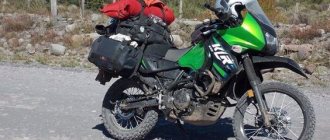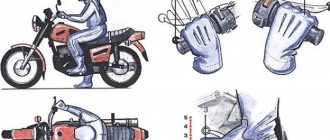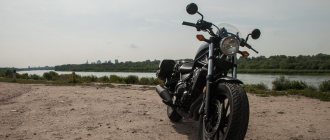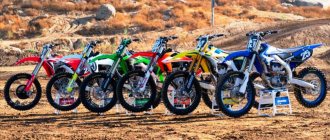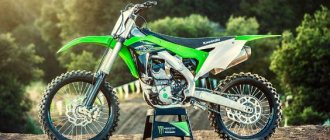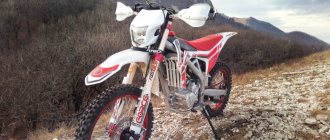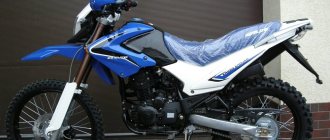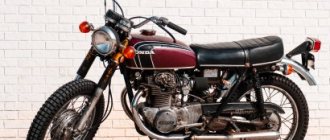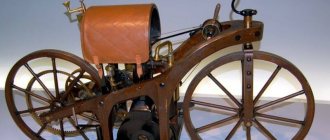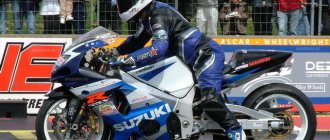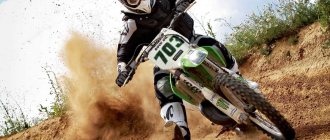One of the most popular motorcycles among beginners is the Honda CB 400 SF. Replacing the Honda CB1 on the assembly line, this bike first went on sale in 1992 , having gone through several restylings since then. It is still produced, still remaining in demand in the markets of many countries. And in Russia, the popularly beloved “Siberian Sea Horse” is the first two-wheeled steel horse for almost a third of all novice motorcyclists.
Design
Honda CB 400 Super Four is a classic incarnate . Japanese engineers decided not to risk flirting with newfangled trends, and for more than a quarter of a century they have been producing approximately the same motorcycle, which has changed only slightly during this time. A round headlight, a flat seat, an elongated gas tank... The Honda CB400 looks like something from the last century, and at the same time looks organic on city streets. This is partly why it is so popular - the classic design appeals to many bikers.
Technical characteristics of Honda CB 400
One of the reasons for the commercial success of the Honda SB 400 is its balanced technical characteristics. This bike handles well, accelerates briskly, brakes confidently and is highly reliable . He is not without some “childhood sores”, but he has more advantages than disadvantages.
Engine
As time has shown, the Honda CB 400 engine turned out to be the most reliable when compared with other 400 cc motorcycles. It is a liquid-cooled inline 4-cylinder power unit ( 53 horsepower and 38 Nm of torque ). Starting from the second generation, that is, from 1999, it acquired the VTek , which the first version of the Honda SB 400 was deprived of, becoming more economical. The engine did not lose its agility, providing acceleration to 100 km/h in 4.5 seconds . The maximum speed of the motorcycle is 180 km/h , and it is really capable of reaching it.
Transmission
The motorcycle is equipped with a 6-speed gearbox , trouble-free, like a Swiss watch. With proper maintenance, a gearbox can serve for decades without breakdowns or repairs, and there are practically no problems with it.
Chassis and brakes
Duplex steel frame , 43 mm telescopic fork at the front, short-stroke shock absorbers at the rear - the design is classic. The Honda CB 400 suspensions may not be the stars of the sky, but they are durable and versatile. The rear shock absorbers are preload adjustable.
Braking is handled by 2-piston calipers (since 1996 - 4-piston ) with two 296 mm discs at the front and a 1-piston caliper with a 240 mm disc at the rear. Since 2008, all versions of the Honda SB 400 have been equipped with an ABS system . Considering the moderate weight of the motorcycle, all of the above is enough for it to brake very effectively.
Electronics
Electronic equipment in the Honda CB 400 is minimal. Analog dashboard, lighting, battery, generator - that's all. Therefore, the electrical circuit of the motorcycle is simple, and if you have a manual at hand, any novice electrician can figure it out. And thanks to the well-thought-out design, there are practically no problems in the on-board network of the bike.
Weight and dimensions
According to these parameters, the Honda CB 400 Super Four is a strong mid-ranger. The length of the motorcycle ranges from 2045 to 2080 mm depending on the year of manufacture, width - from 720 to 735 mm, from 1070 to 1160 mm. Seat height - from 755 to 775 mm. Dry and curb weight - 168-173 and 189-200 kg, respectively.
Controllability
This is one of the biggest reasons why the CB400 is so popular. The motorcycle handles superbly, it obediently responds to any efforts of the driver and easily maneuvers in traffic. Tenacious brakes and dynamic acceleration allow the Honda SB400 to feel like a fish in water in the city.
Fuel consumption
It differs significantly in the first two generations and in all subsequent generations. The least economical are the old Seabikhs, without VTec and with four carburetors. But since 2003, an injector began to be installed on the CB400, and average fuel consumption dropped to 4.5-5 liters .
In the city it can go even more, on the highway - a little less, if you maintain the cruising speed within 110-120 km/h. The bike readily consumes AI-92, but, according to reviews from owners, gasoline consumption on AI-95 is slightly lower.
Advantages of the model
Like any other motorcycle equipment, the CB 400 SF has an impressive list of advantages:
- The reliability of the engine-transmission unit has been proven over more than 20 years of operation;
- Good acceleration of the motorcycle to cruising speed (120–130 km/h), as well as comfortable and quick achievement of 190 km/h – the maximum speed;
- The model is ideal for city travel due to its small dimensions and design features (there is no unnecessary plastic that would limit movement in traffic jams);
- The opportunity to save money during use and scheduled repairs, since parts for this model can be easily found on the motor market, and at a low price;
- The HondaCB 400 SF has great advantages in terms of fuel consumption over the same Suzuki GSF 400 Bandit or DucatiMonster 400 - 4-6 liters versus 5.5-8, which are consumed by the last two motorcycle models;
- Very often, this particular Honda is recommended to novice motorcyclists as their first vehicle because of its flexibility, good handling and light weight.
Motorcycle price
The cost of a used Honda CB 400 can range from 100 to 300-350 thousand rubles , or even more. This model is still produced, but officially it is sold only in Japan, and gets into other countries through the efforts of “gray” dealers. Copies of the first generation can now be found on the secondary market for 100-120 thousand rubles , in a condition ranging from “it will reach the garage and die quietly there” to “a lively and vigorous old man.” The general trend is clear - the younger the motorcycle, the more expensive it is.
Acceleration to hundreds
These are different values - for a classic, the “hyperfur” drives very decently, collectedly and holistically. The main thing is not to place increased demands on her. With due patience and appropriate tires, on what has already become a textbook karting track, it will be possible to unpleasantly surprise many owners of liter sportbikes. Although it is unlikely that the karting track will become a frequent location for the SV400. I somehow faintly imagine the owner of this model in the numerous humps of a racing suit worth half of his motorcycle, grinding down the sliders in vain and struggling to “eat off” the next tenth of a second from his best lap time. And I can totally imagine someone using a motorcycle as a workhorse and going on trips.
Repair and tuning
Due to the enormous popularity of the model, there are enough original spare parts, copies from other manufacturers, and tuning. On average, the cost of any parts is comparable to that for most other Japanese bikes, with the exception of particularly expensive models like the Honda Gold Wing and Suzuki Hayabusa.
Repair
Most of the Honda SB400 models riding on Russian roads have already had a dozen or two owners, and it is unlikely that all of them took good care of their two-wheeled steel horse. Therefore, despite the phenomenal survivability, technical problems sometimes occur. But there is no general trend; the Honda CB 400 is extremely reliable, and all possible breakdowns are most often caused by untimely maintenance.
Spare parts
In large cities, they are usually available in motorcycle shops, and you can buy almost anything - this is due to the popularity of the model. And through services like Exist and Megazip you can order everything that is not in stock. The price of spare parts is quite reasonable.
Tuning
Most owners of the Honda SB 400 limit themselves to visual tuning of the bike, because there is little point in improving what is already good. For many of them, this motorcycle is “passable”; they expect to change it to a more powerful one in a year or two, and therefore do not consider it necessary to invest in tuning.
Interesting Facts
During its entire existence on the motor market, the CB 400 SF model has revealed a number of interesting features:
- Despite its impressive appearance, even short people (up to 165 cm) can ride the motorcycle. Girls who are just starting to learn how to ride a motorcycle can also easily cope with driving a 150-kilogram Honda.
- Many motorcyclists remove the speed limiter on their motorcycle, although anyone can exceed the 200 km/h mark only as an exception.
- The small dimensions of the motorcycle do not in any way affect the comfortable position of both driver and passenger.
- It is better to adjust the front and rear suspensions after purchase, since in the stock configuration they are more suitable for a driver weighing no more than 50 kg.
In conclusion, it is worth saying that the HondaCB 400 SF motorcycle is one of the few legendary models that have found a response in the hearts of a truly huge number of lovers of two-wheeled vehicles. A long history of modifications has made it possible to create equipment that will make riding comfortable and give the motorcyclist a feeling of complete freedom and incomparable pleasure from control.
Motorcycle modifications
The Honda SV 400 SF has lived a long life, having changed considerably during this time. The year 2003 was an important milestone in the history of the development of the model - the third generation, Honda CB400SF Revo, was released with the Vtec 3 system, which replaced the Vtec 2 that had existed for only a year. It was since 2003 that all CB400SFVs received the third generation Vtec.
Honda CB 400 Four 1992
The very first generation of “Sibihi”, without Vtec and with Keihin CV 32 mm carburetors. It became the basis for all further incarnations of the “Sibiha”, and all of them, even those released this year, have a lot in common with it.
Version R 1995
This configuration was produced until 1998 inclusive, differing from the standard one by the presence of a plastic fairing and a square headlight instead of the classic round one.
Version S 1996
In parallel with the Version R, the CB400SF Version S was also produced, with the missing center stand, sporty tuned Keihin carburetors and reinforced 4-piston calipers on the front brake discs.
Version VTec 1999
The first Honda SB400 with the Hyper VTec . Since 1999 , it has been installed on all copies.
Version VTec 2003
A motorcycle with an injection instead of four carburetors. Subsequently, carburetor versions of the CB400 were no longer produced.
Determining the year of manufacture by frame number
| Model | Years of manufacture | Frame number |
| CB400SF 2N | 1992 | NC31: 1000001-1034643 |
| CB400SF 2R | 1993 | NC31: 1200001-1212250 |
| CB400SF 2S | 1994 | NC31: 1300001-1307373 |
| CB400SF 3S | 1995 | NC31: 1350001-1354811 |
| CB400SF 2T | 1996 | NC31: 1400001-1401880 |
| CB400SF 3T | 1996-1997 | NC31: 1450001-1456784 |
| CB400SF 2V | 1997 | NC31: 1500001-… |
| CB400SF 3V | 1997-1998 | NC31: 1550001-… |
| CB400SF Fx | 1999 | NC39: 1000001-1007220 |
| CB400SF | 2000 | NC39: 1010001-1019999 |
| CB400SF F1 | 2001 | NC39: 1020001-1029999 |
| CB400SF F2 | 2002 | NC39: 1030001-1039999 |
| CB400SF F3 | 2003 | NC39: 1040001-1049999 |
| CB400SF F4 | 2004 | NC39: 1050001-1099999 |
| CB4005, CB400S5 | 2005 | NC39: 1100001-… |
| CB4006, CB400S6 | 2006 | NC39: 1200001-… |
| CB4007 | 2007 | NC39: 1300001-… |
| CB4008, CB400S8, CB400A8, CB400SA8 | 2008 | NC42: 100001-… |
| CB4009, CB400S9, CB400A9, CB400SA9 | 2009 | NC42: 110001-119999 |
| CB400A, CB400SA, CB400Aa, CB400SAa | 2010 | NC42: 120001-129999 |
| CB400B, CB400SB, CB400Ab, CB400SAb | 2011 | NC42: 130001-139999 |
| CB400C, CB400SC, CB400Ac, CB400SAc | 2012 | NC42: 140001-149999 |
| CB400D, CB400SD, CB400Ad, CB400SAd | 2013 | NC42: 150001-159999 |
| CB400E, CB400AE, CB400SE, CB400SAE | 2014 | NC42: 160001-169999 |
| CB400AF, CB400SAF | 2015 | NC42: 170001-179999 |
| CB400G, CB400AG, CB400SG, CB400SAG | 2016 | NC42: 180001-189999 |
Advantages and disadvantages
This model has more positive qualities than disadvantages, which was the reason for its unprecedented popularity. If you take proper care of your bike, it will last for decades.
Advantages
- Phenomenal reliability . Problems, of course, do happen, especially with older copies, but still.
- Huge resource . Many Honda CB400 Super Four have already covered several hundred thousand kilometers, and their engines are still in no hurry to retire.
- Controllability . Any beginner can handle a bike, with some skills, of course.
- Cost of service . In terms of maintenance, the motorcycle will not fit into the pocket, and it is unlikely to ruin its owner.
- Economical . If you don’t twist the throttle “all the way”, fuel consumption will be very moderate.
Flaws
- Reputation as a " beginner's bike ". Because of this, many owners do not take proper care of the bike, hoping to sell it soon. Therefore, many copies of the Honda SB400SF are in mediocre technical condition.
- Relatively weak suspensions . It is not recommended to drive off paved roads, especially if there is a passenger.
- Sometimes the charging relay fails.
Those. service
Oil filter
Suitable for many models from different manufacturers, both for motorcycles and cars. DoVtek and Vtek filters are interchangeable. Most Popular:
- HiFlo 303
- Vesrah SF 4007
- KNECHT/MAHLE OC 575
- Mann MW64, W67/1
- Aiko C225
- Sakura 1060 (From Pajero 4 3.0, external dimensions are a little larger but quite suitable).
Connection size: M20x1.15
Air filter
DoVtek - round filter HiFlo HFA1402
VTEC 1999-2007 - oval filter cat. part number 17230-MCE-000, for example EMGO 12-90592
Candles
- CR8EH-9 - hot spark plug, for normal use.
- CR9EH-9 - cold spark plugs, for constant heavy loads.
Valve clearances
Measurements and adjustments for cold conditions .
| Valves | DoVtek | Vtek |
| Intake | 0.12-0.18 mm | 0.17-0.23 mm. |
| Graduation | 0.17-0.23 mm. | 0.24-0.30 mm. |
Brake pads
Dovtek
Regular version
- Front Nissin - 2P-204NS
- Rear Nissin - FD-B531P, 2P-204NS
S version (cb400sfs)
- Front BREMBO calipers - Pads Nissin 2p-270RS, Nissin 2P-270, Vesrah VD-945, TRW MCB 683, TRW MCB 683SV
- Rear caliper Nissin Version S – Ferodo FD-B533P
VTEC
- Front Nissin 2P 245 NS
- Rear caliper Nissin 2P 264 ST
Brake fluid DOT4
Add to comparison
Rating:
| Design | 0 |
| Comfort | 0 |
| Controllability | 0 |
| Reliability | 0 |
| Service cost | 0 |
| Price | 0 |
| Average | |
Like? Like it!
Owner reviews
I bought a motorcycle in May 2021, year of manufacture 1999, first with Vtek, dragged from Japan from auction. In fact, I bought it purely from the photo, before that I had only sat on the same model and tried it on. Mot arrived alive, vigorous, with scratches on his sides, but all this was visible in the photographs. I’m still driving it, there are already 46k km on the odometer, although the mileage is 100% correct. The bike is very peppy, the technical characteristics are up to par, I like everything. Evgeniy, St. Petersburg.
An excellent moped with a comfortable fit, the size and weight are a little annoying, but this is an individual problem (height 161, weight 50+). I rode for two years until it was stolen, then I switched to a Jixer 600. Alina, Moscow.
Sibikha Super Four is the best motorcycle for driving around the city, and not only. I compared it with the XJR 400, the difference is huge, and not in favor of the Yamaha - it’s heavier, more clumsy, the brakes are worse. Honda rules! Sergey, Krasnodar.
Summary
Advantages
- Classic timeless design.
- One of the most inexpensive options in the 400 cm3 class.
- Reliable, repairable, no problems with spare parts.
- Maneuverable and dynamic. Light weight.
Flaws
- There are many motorcycles on the market that are in poor condition because... Very often this motorcycle is taken for study.
- Soft front fork. The problem is solved by installing stiffer springs or replacing the oil with a more viscous one.
- Problematic regulator relay on models before 1999. The relay itself is not expensive, but it is worth carrying a spare one when traveling long distances.
- The exhaust manifold under the bottom beats during unsuccessful exits from curbs. The solution may be to install a power steel plow.
- Sensitivity to air filter contamination.
Conclusion
The Honda CB 400 gives new riders what they need - balance . This bike is a strong mid-ranger in all respects; it accelerates quickly, brakes confidently and maneuvers well . In addition, it is inexpensive, which is also important.
Specifications
| Maximum engine power: | 53 HP |
| Torque: | 38 Nm |
| Working volume: | 399 cm3 |
| Motor type (cylinder arrangement, number of strokes): | 4-cylinder, transverse DOCH, PGM-FI fuel injection system |
| Number of cylinders: | 4 |
| Number of valves: | |
| Intake type (Injector / Carburetor): | |
| Bore and stroke: | |
| Starting system (Electric starter, kick starter): | |
| Maximum speed in km/h: | 180 km/h |
| Cooling system: | Liquid cooling |
| Transmission (gearbox): | 6 |
| Clutch (Dry / Wet): | |
| Drive unit: | Chain |
| Frame: | Steel duplex frame |
| Chassis | |
| Suspension (front/rear travel): | |
| Brakes (Front/Rear): | |
| Wheels / Tires / Rubber: | |
| Dimensions and weight | |
| Dimensions (Length / Width): | |
| Seat height: | |
| Ground clearance: | |
| Curb weight: | |
| Wheelbase: | 1455 mm |
| Weight: | 189-200 kg |
| Fuel tank capacity: | 18 l. |
| Battery capacity: | |
| Year of release: | |
| Country of Origin: |
